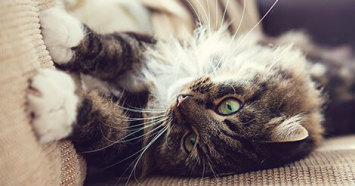
A cat who uses the corner of your sofa (or other furniture) as a scratching post can be incredibly destructive. Even though cats are small their claws are sharp and can rip through fabrics leaving strings hanging where none were before. In fact, scratching at furniture is one of the most frequently mentioned feline behavior problem; second only to litter box issues.
Scratching is Natural
While it’s not going to make you feel better if your furniture is already damaged, scratching on furniture is a natural behavior. When your cat reaches up on the furniture, stretching above his head to grab the fabric, he’s stretching his muscles. Reaching up, arching his back, then flexing, he’s loosening all the muscles in his body. He feels good after a good stretch.
Your cat also has small scent glands between his toes. These interdigital glands leave a bit of your cat’s individual scent each time his claws flex on the fabric. He’s telling the world (or everyone in your household), “I’ve been here.”
These scratching actions also keep your cat’s claws healthy. As he grabs the fabric with his claws and pulls downward, any claw sheaths (the outer covering of each claw) that are old and ready to be shed will be pulled off. If you look on the floor where he regularly scratches, you’ll find a claw sheath or two.
Last but certainly not least, cats scratch because they like it. It’s natural, they feel good doing it, and afterwards they are awake and happy.
How to Stop Cats from Clawing Furniture
Since all cats need to scratch, it’s important to provide several places where your cat will want to scratch rather than using your furniture. Commercial cat trees are great as they are designed for use by cats and are covered with carpet, rope, or a combination of the two. Most cats like both carpet and rope but the rope seems to slightly edge out carpet. Cats can probably get a better grip on it.
You can make your own cat trees too, if you have the tools and skills. However, study the commercially-offered cat trees first to see what cats tend to like.
There are also a variety of other scratching options offered by pet supply outlets. There are cardboard toys, carpeted tunnels, and more. Cat trees, however, seem to work the best as they provide more opportunity for the cat to reach high and stretch.
Position the cat trees in the areas where your cat spends time — near the litter box or the cat’s food, close to a favorite napping spot, or where the family spends a lot of time. Place one in front of the area on your furniture where you cat prefers to scratch. If your cat likes catnip, sprinkle catnip in a few different places on each tree. Have a couple of toys on each tree, also, to get your cat’s attention. When the cat is using the tree to scratch, play, or nap, make sure you pet her, play with her, and offer a treat or two. Reward her for using the tree.
Make Your Furniture Unappealing
Don’t try to correct or punish your cat for scratching on your furniture. Cats don’t react well to these training techniques and you will be more likely to damage your relationship with your cat.
Instead, make your furniture unappealing so your cat doesn’t want to use it. If it will be safe on your furniture, spray some white vinegar on the scratched areas so they smell bad to your cat. A piece of rubber matting (the soft bendable kind) can be fastened over the scratched area so the used area is no longer attractive to your cat. Some cat owners also have good luck using double stick tape on the scratched areas.
Habits Are Hard to Break
Once you begin changing your cat’s scratching habit, keep in mind habits are hard to break. If your cat has been doing this for a while, he’s going to try and continue doing it. Pay attention, be ready to protect your furniture, and continue to make the cat trees more inviting and fun.